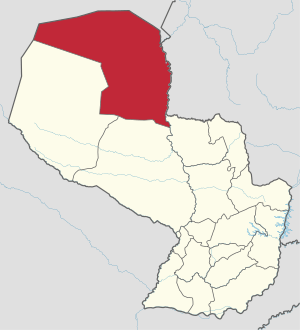Alto Paraguay facts for kids
Quick facts for kids
Alto Paraguay
Departamento de Alto Paraguay
|
|||
|---|---|---|---|
|
|||
 |
|||
| Country | |||
| Capital | Fuerte Olimpo | ||
| Area | |||
| • Total | 82,349 km2 (31,795 sq mi) | ||
| Population
(2002)
|
|||
| • Total | 15,008 | ||
| • Density | 0.182249/km2 (0.472022/sq mi) | ||
| Time zone | UTC-04 (AST) | ||
| • Summer (DST) | UTC-03 (ADT) | ||
| ISO 3166 code | PY-16 | ||
| Number of Districts | 2 | ||
The Alto Paraguay Department (which means Upper Paraguay) is a large region in Paraguay. It is one of the 17 departments that make up the country. Think of a department like a state or a province. The main town and capital of this department is Fuerte Olimpo.
Alto Paraguay is known for being very vast but also very sparsely populated. It covers a huge area of 82,349 square kilometers, which is bigger than many countries! However, only about 15,000 people live there. This makes it one of the least populated areas in Paraguay.
Contents
Districts of Alto Paraguay
A department is usually divided into smaller areas called districts. Alto Paraguay has five main districts. These districts help manage the different parts of the department.
Geography and Environment
Alto Paraguay is located in the northern part of the Gran Chaco region. This area is known for its unique wildlife and landscapes. You can find dry forests, savannas, and wetlands here. The Paraguay River forms part of its eastern border. This river is very important for transportation and the local environment.
The climate in Alto Paraguay is generally hot. It has a dry season and a rainy season. This affects the types of plants and animals that can live there. Many parts of the department are still wild and undeveloped.
Economy and Life
Because Alto Paraguay is so big and has few people, its economy is mostly based on ranching. Raising cattle is a major activity here. Some farming also takes place, like growing sorghum and sugarcane. These crops are important for feeding people and animals.
Life in Alto Paraguay can be challenging due to its remote location. However, the people who live there are very connected to the land. They often rely on natural resources for their daily needs. The department is also home to several indigenous communities.
Related pages
Images for kids
See also






